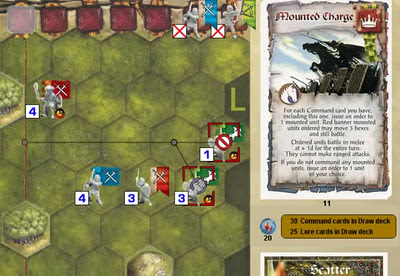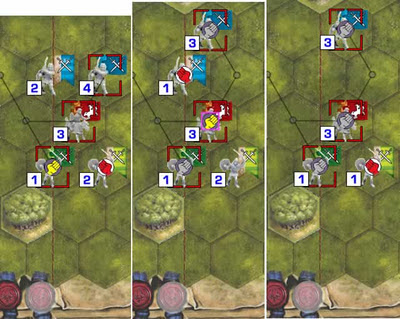 When I left off, my left flank was being pounded. My poor move with the blue infantry resulted in it being reduced to 1, trying to cover the green goblin archers, which were also at 1. It was time to call for a retreat, and hope my opponent did not have any more cards to follow up.
When I left off, my left flank was being pounded. My poor move with the blue infantry resulted in it being reduced to 1, trying to cover the green goblin archers, which were also at 1. It was time to call for a retreat, and hope my opponent did not have any more cards to follow up. But, he did have the cards. It was too late. My opponent had scored the first victory and was poised to get another victory banner, if he continued to have cards on that flank. It was now 0-1.
But, he did have the cards. It was too late. My opponent had scored the first victory and was poised to get another victory banner, if he continued to have cards on that flank. It was now 0-1. I like games that are learning experiences. For my opponent, this was one. He had forgotten that dragons (and creatures in general) can move out-of-section. What's better is that when you get an Advance card and have a high Command value (six, in my case) you often throw away orders as you don't have enough units in that particular section. Creatures also help in using up excess orders. So, I played Advance Right and moved forward my battle line. I also moved the dragon forward, chomped on the enemy's green swordsman, but wouldn't you know it, he rolled two Flags and again my red dragon was forced to retreat!
I like games that are learning experiences. For my opponent, this was one. He had forgotten that dragons (and creatures in general) can move out-of-section. What's better is that when you get an Advance card and have a high Command value (six, in my case) you often throw away orders as you don't have enough units in that particular section. Creatures also help in using up excess orders. So, I played Advance Right and moved forward my battle line. I also moved the dragon forward, chomped on the enemy's green swordsman, but wouldn't you know it, he rolled two Flags and again my red dragon was forced to retreat! As I kept drawing center cards I realized that meant that he had to have the flank cards. The green goblin archer I had been trying to protect all along finally went down. It was now 0-2.
As I kept drawing center cards I realized that meant that he had to have the flank cards. The green goblin archer I had been trying to protect all along finally went down. It was now 0-2. Even worse, his blue infantry attack scores heavily on my green goblin lizard riders. They exact revenge in battle back, however, but it looks like a third victory banner is in the making unless I stop this attack.
Even worse, his blue infantry attack scores heavily on my green goblin lizard riders. They exact revenge in battle back, however, but it looks like a third victory banner is in the making unless I stop this attack.On the opposite flank my Red Cavalry had charged in an destroyed the weakened green archer unit, then in follow-up has weakened the blue swords on the end of the line. The score was now tied at 2-2, and things started looking less anxious again. But, I knew that the Lizard Riders on my left flank were easy pickings, if my opponent had another right flank card...
Which of course, he did. The score was now 2-3.
My opponent played a Foot Onslaught card and pressed forward with this battle line. Darn! My whole plan of using the red dragon to flame that line just disappeared. I had waited too long, doing too many other things, so the opportunity had passed.
It was at this point that a critical error occurred. The enemy blue swords attack the green archers and get two Flags (of course!). The green archer can ignore one flag, but it has to take the other. I mistakenly take a hit and battle back, but as you can see, a retreat path is actually open for him. In fact, he should have simply taken both flags, getting him out of that death trap. Ah well, the heat of the battle prevails...
In the end, that error cost me dearly, probably the game. Although it fought fiercely and killed two blue and 1 red in battle backs, it went down to the third attack and making the game a precarious 2-4.
I bring my red dragon back into play, set the red infantry alight (again with two tokens!) and land in the sweet spot. From there I can either breathe on the two cavalry and land back in the woods, or breathe on two infantry (red and blue) and land back in the woods.
Meanwhile, my two attacking blue infantry finish off the weakened enemy blue infantry at the end of the line. But not before he battles back hard, weakening my first attacking unit.
The score is now 3-4, and his weakened red infantry is alight with two Fire tokens.
My opponent is close to victory - two victory banners away - and clearly he can taste it. He launches his weakened blue unit against mine, killing it with help from the Leadership card. He Takes Ground, putting the unit out of reach of my red dragon and a breath attack!
The score is now 3-5 and the tension is palpable. (You know I just had to say that!)
I drew a brilliant card - Forward, my opponent's favorite - and I turtle up with my units on my left. This will force my opponent to play two cards (on average) to get his red infantry back into play.
Next, I set the cavalry on fire. I only got one Fire token on each, but that is four lore to put them out. As you can see in the picture, the red infantry is at 1 figure remaining, so he will be destroyed next turn, bringing the score up to 4-5. That means if I can destroy two weakened units this turn, that is game, and a victory to me. Considering I have been behind the entire game, that would be sweet.
And here are the two I need to kill, the blue swords and the green swords, both at two figures remaining.
Two dice from my green infantry against his green infantry is 11% to destroy the unit and 44% chance to get only one hit. If I get a retreat (31% chance) it would mean I won't win this turn.
Three dice from my blue infantry gives a 26% chance of wiping the unit out and a 44% chance of getting only a single hit.
I decide to risk it and attack with the green and the blue first, then let the red cavalry mop up the weakened units. As long as no one retreats, I could get them both right here.
That hurt. The green attack failed to score any damage, but brought my own unit down badly in battle back.
The blue attack weakened the enemy further, but in battle back I was forced to retreat, leaving my red cavalry out of support.
My red cavalry did finish off the blue swords, making the game 4-5, but in the Bonus Melee Attack the green swords held out. I was not going to win at the beginning of next turn. And with that green sword of mine at a very weakened state, he would be vulnerable, and likely to be destroyed, losing me the game.
At the start of the next turn the hapless red infantry goes up in smoke, bringing the game to 5-5.
Clearly my opponent had been saving up for this one. He later confided that he had been holding the Enchanted Mass Might since the beginning of the game. Combined with the Mounted Charge card, his units would be +2 battle dice in combat. Further, now that the cavalry were ordered, he could put out their fires. With the lore card and the removal of the Fire tokens it cost his 11 lore; exactly what he had. If only I had gotten two Fire tokens on at least one of them...
This was a great play and now he was going to be able to make a power move against me, with cavalry, much as I had done to him many times before. Payback is a pain...
Summary
This was a good game although for me it never really felt close until the end. I always felt behind and on the defensive, which is something I try not to do. I prefer to act rather than react, and make my opponent address my game, rather than address his.
When I played Blue Banners, I should have opened the line with the single unit moving one hex. This would have placed it away from the hill and outside of the one-move reach of the enemy red swords unit. I should have immediately followed up, as I did in the game, with the play of the Patrol Left card, allowing the green Goblin archers to duck into the rear, and the blue swords seal the line. From this position the green Goblin archers still serve a very useful purpose - they provide support for the green Goblin Lizard Riders.
Considering that my original plan was to essentially refuse that flank, my move aggressively forward was indefensible. It broke the line of support and allowed my opponent to use fewer cards to get his attacks. Granted, he had more than enough cards to attack with, but in the end it cost me three victory banners. It was this early action where the battle was lost. No matter what the subsequent rolls at the end, I cannot blame luck.
All in all it was a great game and my opponent played well. It was tense at the end and came down to who would make their die rolls. It made for a fun night.
If you want to try BattleLore on Vassal, or any other in the Command and Colors series, drop me an email.



















































